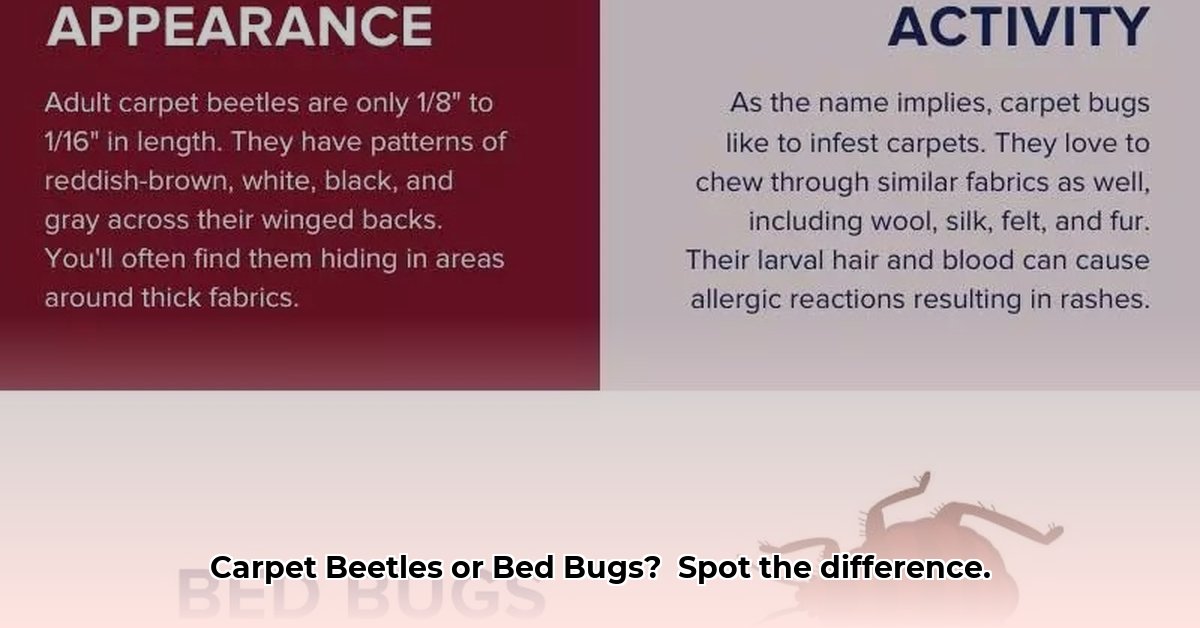Stop the itch and damage! Suspect you have tiny invaders? This guide helps you quickly determine if you’re dealing with carpet beetles or bed bugs, offering clear identification tips and effective control strategies. Don’t panic—we’ll help you reclaim your home.
Visual Comparison: Spot the Difference
This chart highlights key differences between carpet beetles and bed bugs, aiding quick identification:
| Feature | Carpet Beetle (Adult) | Carpet Beetle (Larva) | Bed Bug (Adult) | Bed Bug (Nymph) |
|---|---|---|---|---|
| Size | ~1/5 inch (1-4mm) | ~1/5 inch (1-4mm) | ~1/4 inch (4-5mm), like an apple seed | 1.5-4.5mm |
| Shape | Oval, hard shell | Elongated, worm-like, hairy | Oval, flat, like a lentil | Similar to adult, but smaller |
| Color | Varied (brown, black, mottled) | Brownish-tan, often with stripes | Reddish-brown | Pale yellow or translucent |
| Markings | May have distinct patterns | May have stripes | No noticeable markings | No noticeable markings |
| Bites | No (larvae hairs may irritate) | No | Yes, itchy welts often in lines or clusters | Yes, itchy welts |
Carpet Beetles: The Fiber Fanatics
Life Cycle & Behavior
Carpet beetles undergo complete metamorphosis: egg, larva, pupa, adult. Adult beetles are attracted to light and pollen, often found near windows. The larvae, however, are the true culprits behind damage, preferring dark, undisturbed areas like closets, carpets, and stored items where they feed on natural fibers.
Habitat & Damage
Carpet beetle larvae feast on animal-based materials like wool, silk, fur, feathers, and leather. Signs of infestation include damaged fabrics, shed larval skins, and small, brown fecal pellets.
Treatment & Prevention
- Thorough cleaning: Vacuum carpets, rugs, upholstery, and crevices. Dispose of the vacuum bag immediately.
- Laundering: Wash infested items in hot water (at least 120°F) and dry on high heat.
- Freezing: Freezing items for several days can kill all life stages.
- Targeted insecticides: Use insecticides judiciously, focusing on infested areas. Consider less toxic options first.
- Source identification: Eliminate the source of the infestation (e.g., old bird’s nest, pet food).
- Regular cleaning: Vacuum frequently and pay attention to areas where pet hair accumulates.
Bed Bugs: The Midnight Snackers
Life Cycle & Behavior
Bed bugs also undergo complete metamorphosis. They are nocturnal feeders, attracted to body heat and carbon dioxide. After feeding, they retreat to hiding places like mattress seams, box springs, bed frames, and cracks in walls.
Habitat & Damage
Bed bugs exclusively feed on blood. Bites leave itchy, red welts, often arranged in lines or clusters. Beyond physical irritation, infestations cause significant psychological stress, anxiety, and sleep disturbances.
Treatment & Prevention
- Professional pest control: Due to insecticide resistance and their elusive nature, professional treatment is often the most effective solution.
- Heat treatment: A highly effective method that kills bed bugs at all life stages.
- Mattress encasements: Trap existing bugs and prevent new ones from infesting.
- Vacuuming and Laundering: Important steps to reduce the population, but rarely sufficient for complete eradication.
- Integrated Pest Management (IPM): Professionals often use a combination of methods for long-term control.
- Regular inspection: Check mattresses, especially when traveling, and inspect luggage after trips.
Troubleshooting & FAQs
Q: My carpet beetle treatment isn’t working. Why?
A: Ensure you’ve treated all potential hiding places and removed the infestation source. Persistent effort is crucial. If the problem continues, consult a pest control professional.
Q: My bed bug treatment isn’t working. Why?
A: Bed bugs are notoriously resistant to many insecticides. Professional treatment is usually necessary for eradication. Re-introduction from adjacent units is also possible. Discuss IPM strategies with your pest control professional.
Q: My landlord won’t address the bed bugs. What can I do?
A: Document the infestation (photos, dates), keep records of communication with your landlord, and consult your local tenant rights laws. Contact your local housing authority if necessary.
Resources & Further Reading
- EPA Bed Bug Information
- Your Local University Extension Service (search online for your state’s extension service)
Last Updated: October 26, 2023
This guide provides general information. Pest control recommendations may vary based on specific situations and local regulations. Consulting a qualified pest control professional is always recommended for severe infestations. Ongoing research continually updates best practices for pest control, so staying informed is beneficial. Always exercise caution when using insecticides and follow label instructions precisely.
- Wellness Fair Ideas for Work to Boost Employee Wellbeing - December 15, 2025
- Affordable Employee Wellness Fair Ideas for Any Budget - December 14, 2025
- Employee Wellness Programs Strategically Benefit Employee Health And Retention - December 13, 2025
















